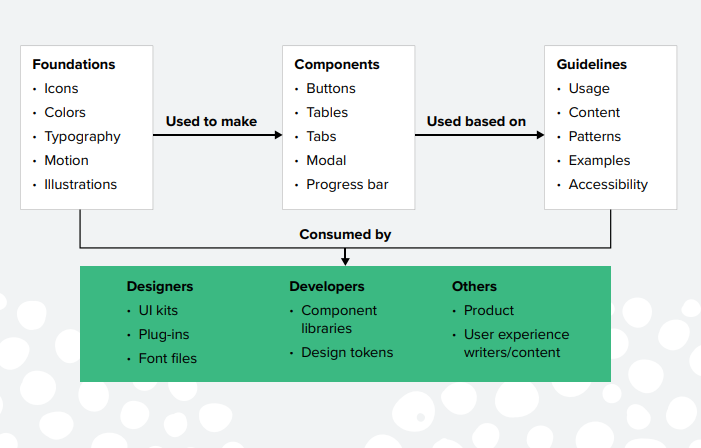If you want to deliver consistently great CX, use a design system | Forrester
Customer Experiences
The Digital Experience Design Opportunity For CX Pros
Advance CX By Accelerating Design Efficiency
What Is A Design System?
It is a set of principles, foundations, components, guidelines, and resources that an organization creates and continually evolves to guide its design efforts.
The following components make up a comprehensive design system for digital experiences:

Is A Design System Worth The Effort?
My Company Has A Design System. Mission Accomplished?
Likely not. Design systems are relatively nascent, often requiring refinement through iterations. Three common challenges in their development include:
- Lack of customer research: Relying on assumptions and bypassing thorough user research can result in design systems that don’t align with customer needs.
- Oversight of important areas: Areas like notifications and chatbots are frequently overlooked. Despite their significance in customer journeys, fewer than half of design teams focus on notifications, and even fewer address chatbots, contributing to the negative consumer perception of the latter.
- Insufficient socialization: For a design system to be effective, it must be integrated into a company’s culture. This extends beyond one-time design thinking training; employees should easily grasp how the system pertains to their specific roles.
How To Set Up A Successful Design System
Bring Design In
Gaining approval remains a persistent challenge for CX professionals. Additionally, avoiding the perception of intruding into departments and claiming superior knowledge is crucial. To ensure the success of a design system and infuse customer-centricity into digital experiences, initiating the relationship correctly is essential.
For organizations without a design system, elucidate the advantages for designers: more time for creative endeavors, reduced time spent on repetitive queries, and increased ability to identify and address “rogue” or “shadow” design practices (e.g., employees creating their own customer-facing forms).
WHO SHOULD DESIGN?
Unregulated design practices often irk designers. While promoting inclusive design has its merits, not everyone possesses the capability or should engage in design. Design thinking, aimed at instilling a designer’s mindset, is occasionally misunderstood as advocating that all employees become designers. This misconception disregards the specialized skill sets unique to designers, which cannot be substituted or replicated through a one-time design thinking course.
Contrarily, external perspectives enhance design endeavors: a software engineer might alleviate the influx of bug reports by identifying crucial user-preferred features, or a receptionist could streamline the front-desk sign-in process by pinpointing time-wasting steps.
Conduct User Research
The specific details of your design system, such as typography, icons, and component libraries, will likely be unique to your organization. However, one element that universally benefits every organization is the codification of digital accessibility best practices into their design system.
Digital accessibility refers to the extent to which customers can derive value from a digital experience, irrespective of variations in their abilities. This includes considerations for customers who use screen readers, ensuring they can navigate digital properties with ease.
There are two significant reasons to incorporate accessibility into your design system:
- Overlooking digital accessibility means missing out on significant economic opportunities. Globally, around 1 billion people have disabilities, representing $1.2 trillion in annual disposable income. Moreover, digital accessibility has a “curb-cut effect,” enhancing experiences for everyone, similar to how curb cuts, initially designed for wheelchair users, also benefit workers pushing heavy carts and parents with strollers.
- Embracing digital accessibility helps mitigate legal risks. In the US, 48% of the top 500 retailers have faced lawsuits under the Americans with Disabilities Act. Domino’s, for instance, experienced the consequences of neglecting digital accessibility, facing legal challenges and negative public relations.
Design System Rollout
Begin by reviewing the design system checklist to verify the completeness of all components. Start with a small-scale implementation, recognizing that iteration is part of the process. Initiate the system within a team with whom you have a strong working relationship, such as product teams.
Establish a two-way communication channel, emphasizing that the goal is to enhance design across the organization, enabling designers to engage in more creative work. Create transparent feedback mechanisms and collaborative processes to ensure the success of the design system.
Understand that implementing a design system is not a one-time effort. After testing and refining, gradually extend the system to the broader organization. Similar to any CX initiative, this expansion requires careful training and execution, incorporating feedback loops. Anticipate the need for ongoing refinement and improvement as your organization evolves.
DesignOps: The Next Frontier
As the importance and complexity of design continue to escalate, driven by new digital touchpoints, evolving customer expectations, and unforeseen events like the COVID-19 pandemic, forward-thinking organizations are establishing a DesignOps function to enhance efficiency.
Forrester’s annual survey of design professionals suggests that a threshold of five or more XD professionals is ideal for initiating a DesignOps function. The primary objectives of DesignOps encompass refining design processes, facilitating the onboarding of new team members, contributing to the development of the design system, and overseeing design training and education.
DesignOps teams, such as Atlassian’s centralized unit, concentrate on critical aspects like design hiring, onboarding, education, and optimizing the distribution of work between internal designers and external XD providers. The culture-focused and strategically oriented nature of DesignOps opens up avenues for CX professionals to integrate customer-centric design principles into their organizations.
As your XD team expands, explore opportunities for your CX team to either spearhead or support the establishment of a DesignOps function.
The Table of Contents of “Seize The Design System Opportunity” Guide:
- The Digital Experience Design Opportunity For CX Pros
- Advance CX By Accelerating Design Efficiency
- What Is A Design System?
- Is A Design System Worth The Effort?
- My Company Has A Design System. Mission Accomplished?
- How To Set Up A Successful Design System
- Bring Design In
- WHO SHOULD DESIGN?
- Conduct User Research
- Codify Digital Accessibility
- Design System Rollout
- DesignOps: The Next Frontier
Number of Pages:
- 10 pages
Pricing:
- Free






